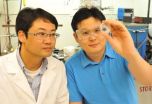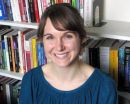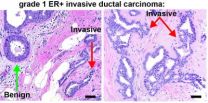(Press-News.org) KNOXVILLE—Researchers at the University of Tennessee, Knoxville, are a step closer to creating a prophylactic drug that would neutralize the deadly effects of the chemical weapons used in Syria and elsewhere.
Jeremy Smith, UT-ORNL Governor's Chair and an expert in computational biology, is part of the team that is trying to engineer enzymes—called bioscavengers—so they work more efficiently against chemical weapons. The work is a joint effort between scientists at UT, Oak Ridge National Laboratory and a French national laboratory in Grenoble. Their study was published recently in the Journal of Physical Chemistry.
Nerve agents, such as sarin, are among the most highly toxic chemical weapons. The study focuses on engineering enzymes that catalyze the hydrolysis of nerve agents as a prophylactic approach to diminishing their toxic effects.
"Enzymes exist that can potentially chew up nerve agents and render them useless before they've had time to act, but they need to be improved to work faster," Smith said.
The researchers are using neutron scattering and computational sciences to study these nerve agent bioscavengers. Neutron scattering allows the scientists to get a detailed three-dimensional view of the enzymes. Computer simulation then uses this view to understand how the enzymes break down the nerve agents.
"The simulations produced an unexpected result," Smith said. "The enzymes break down sarin in an unusual way. Now we can use that result to engineer them rationally."
The team is seeking funding for research into how the enzyme—a protein that doesn't exist in the human body but is made in nature by squid—can be modified so it is more efficient in degrading specific nerve agents. There is much work to be done, including introducing key changes, or mutations, that would improve the activity of the enzyme.
"Using an enzyme from a squid as a bioscavenger in humans is problematic because the human body will recognize it as a foreign substance and chop it up," said research team member Jerry Parks, a research staff scientist in ORNL's Biosciences Division. "Other groups have already shown possible ways to get around that problem. Also, there happens to be a similar enzyme in humans that is currently being developed by other groups. Information from our study may benefit them too."
Ultimately, the researchers will have to figure out the best way to administer the enzyme to humans. It probably would be an injection, but it could be an aerosol spray or a patch. Still, the work holds promise to help make the world a safer place.
"We hope that prophylactically administering efficient bioscavengers will make the use of nerve agents much less attractive to belligerents," Smith said.
INFORMATION:
University of Tennessee discoveries could help neutralize chemical weapons
UT, ORNL collaborate on bioscavengers
2014-06-16
ELSE PRESS RELEASES FROM THIS DATE:
Migratory birds help spread plant species across hemispheres
2014-06-16
A new study out of the University of Connecticut demonstrates for the first time how some plants travel not just across the backyard, but as far as from Northern to Southern hemispheres on the wings of migratory birds.
The findings, published in the online journal PeerJ, offer critical insight into the ecology and evolution of plants that are represented across both continents of the Americas.
The study found 23 regenerative plant diaspores – plant seeds or spores – trapped in the feathers of migratory birds leaving the Arctic harbor for South America.
Although wind ...
Vitamin A derivative potentially treats type 2 diabetes and prevents its complications
2014-06-16
At a time when obesity, type 2 diabetes, and their complications are a veritable epidemic worldwide, researchers at the University of Montreal and CHUM Research Centre (CRCHUM) recently demonstrated the potential of retinoic acid (RA), a derivative of Vitamin A, in treating obesity and type 2 diabetes and preventing their cardiovascular complications. The findings were presented June 6, 2014 at the Annual Conference of the Canadian Nutrition Society in Saint John's, Newfoundland.
"In obese and insulin resistant mice, retinoic acid reduces the risk of cardiac apoptosis, ...
Researchers use virus to reveal nanopore physics
2014-06-16
PROVIDENCE, R.I. [Brown University] — Nanopores may one day lead a revolution in DNA sequencing. By sliding DNA molecules one at a time through tiny holes in a thin membrane, it may be possible to decode long stretches of DNA at lightning speeds. Scientists, however, haven't quite figured out the physics of how polymer strands like DNA interact with nanopores. Now, with the help of a particular type of virus, researchers from Brown University have shed new light on this nanoscale physics.
"What got us interested in this was that everybody in the field studied DNA and ...
Strokefinder quickly differentiates bleeding strokes from clot-induced strokes
2014-06-16
The results from the initial clinical studies involving the microwave helmet Strokefinder confirm the usefulness of microwaves for rapid and accurate diagnosis of stroke patients. This is shown in a scientific article being published on June 16. Strokefinder enables earlier diagnosis than current methods, which improves the possibility to counteract brain damage.
In the article, researchers from Chalmers University of Technology, Sahlgrenska Academy and Sahlgrenska University Hospital present results from the initial patient studies completed last year. The study included ...
E-cigarettes far less harmful than cigarettes, says researcher at INFORMS Conference
2014-06-16
A London School of Economics researcher examining the public and private dangers of drugs argues against demonizing e-cigarettes in a presentation being given at a conference of the Institute for Operations Research and the Management Sciences (INFORMS). He also calls on public officials to recognize that alcohol causes greater harm than other recreational drugs and more public attention should be paid to controlling its harmful effects.
Lawrence D. Phillips, an emeritus professor at the London School of Economics, will present his research group's findings about the relative ...
Most millennial moms who skip college also skip marriage
2014-06-16
Waiting until marriage to have babies is now "unusual" among less-educated adults close to 30 years old, Johns Hopkins University researchers found.
"Clearly the role of marriage in fertility and family formation is now modest in early adulthood and the lofty place that marriage once held among the markers of adulthood is in serious question," sociologist Andrew J. Cherlin said. "It is now unusual for non-college graduates who have children in their teens and 20s to have all of them within marriage."
Among parents aged 26 to 31 who didn't graduate from college, 74 ...
Regenerating our kidneys
2014-06-16
Doctors and scientists have for years been astonished to observe patients with kidney disease experiencing renal regeneration. The kidney, unlike its neighbor the liver, was universally understood to be a static organ once it had fully developed.
Now a new study conducted by researchers at Sheba Medical Center, Tel Aviv University and Stanford University turns that theory on its head by pinpointing the precise cellular signalling responsible for renal regeneration and exposing the multi-layered nature of kidney growth. The research, in Cell Reports, was conducted by principal ...
WSU researchers develop fuel cells for increased airplane efficiency
2014-06-16
PULLMAN, Wash.–Washington State University researchers have developed the first fuel cell that can directly convert fuels, such as jet fuel or gasoline, to electricity, providing a dramatically more energy-efficient way to create electric power for planes or cars.
Led by Professors Su Ha and M. Grant Norton in the Voiland College of Engineering and Architecture, the researchers have published the results of their work in the May edition of Energy Technology. A second paper on using their fuel cell with gasoline has been accepted for publication in the Journal of Power ...
Sleep quality and duration improve cognition in aging populations
2014-06-16
EUGENE, Ore. -- (June 16, 2014) -- Maybe turning to sleep gadgets -- wristbands, sound therapy and sleep-monitoring smartphone apps -- is a good idea. A new University of Oregon-led study of middle-aged or older people who get six to nine hours of sleep a night think better than those sleeping fewer or more hours.
The study, published in the June issue of the Journal of Clinical Sleep Medicine, reaffirms numerous small-scale studies in the United States, Western Europe and Japan, but it does so using data compiled across six middle-income nations and involving more than ...
Tugging on the 'malignant' switch
2014-06-16
Cambridge, Mass. – June 16, 2014 – A team of researchers led by David J. Mooney, Robert P. Pinkas Family Professor of Bioengineering at the Harvard School of Engineering and Applied Sciences, have identified a possible mechanism by which normal cells turn malignant in mammary epithelial tissues, the tissues frequently involved in breast cancer.
Dense mammary tissue has long been recognized as a strong indicator of risk for breast cancer. This is why regular breast examinations are considered essential to early detection. Until now, however, the significance of that tissue ...
LAST 30 PRESS RELEASES:
The perfect plastic? Plant-based, fully saltwater degradable, zero microplastics
Bias in data may be blocking AI’s potential to combat antibiotic resistance
Article-level metrics would provide more recognition to most researchers than journal-level metrics
Satiety’s little helper: Protein that supports appetite regulating protein identified
UF dives deep into predicting storm damage with computer models
A stormy ocean voyage yields insights on the global carbon cycle
Scientists identify first non-coding gene that controls cell size
Demonstration of altermagnetism in RuO₂ thin films -- A new magnetic material for the AI era
Penn researchers awarded $25M to conduct trial using smartphones to fight heart disease
PCORI awards funding for new patient-centered healthcare research
Exploring the origins of the universe: 145 low-noise amplifiers complete ALMA telescopes
Empress cicada wings help illuminate molecular structure
Using sound waves to detect helium
Time burden in patients with metastatic breast and ovarian cancer from clinic and home demands
Researchers discover bias in AI models that analyze pathology samples
Scientists ID potential way to prevent brain injuries from triggering Alzheimer's
MASTER 2nd Open Call: Execution period kick-off
Algae for health in food and pharma
Advanced microrobots driven by acoustic and magnetic fields for biomedical applications
Chicago health information leader recognized for raising CPR readiness and blood pressure awareness
The Intimate Animal, a new book from Kinsey Institute Executive Director Dr. Justin Garcia
When blue-collar workers lose union protection, they try self-employment
New video dataset to advance AI for health care
MEA-based graph deviation network for early autism syndrome signatures in human forebrain organoids
New modeling approach sheds light on rare gut disease
Study documents potentially hazardous flame retardants in firefighter gear
Can certain bacteria regulate aging of the immune system and its related alterations?
AI model helps diagnose often undetected heart disease from simple EKG
There are fewer online trolls than people think
Cell membrane fluctuations produce electricity
[Press-News.org] University of Tennessee discoveries could help neutralize chemical weaponsUT, ORNL collaborate on bioscavengers




